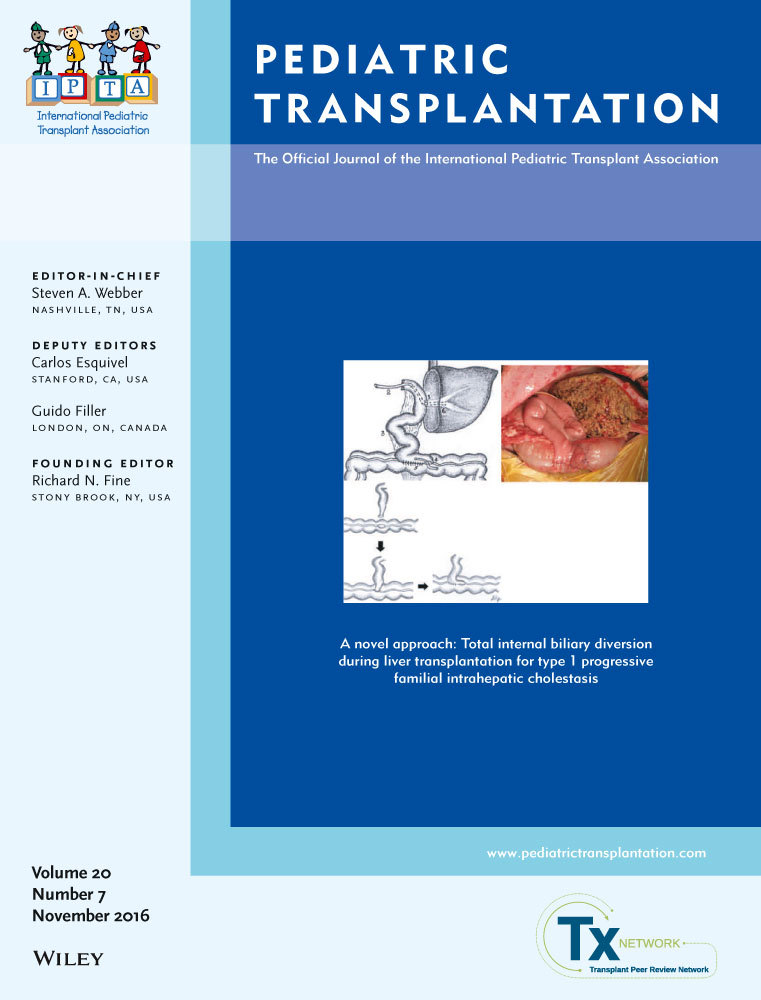Editorial
The tip of the iceberg: outcomes after liver transplantation for very young infants
Alex Bondec,
Alex Bondec
Division of Pediatric Surgery, Pediatric Liver Care Center, Cincinnati Children's Hospital, Cincinnati, OH, USA
Search for more papers by this author John Bucuvalas,
John Bucuvalas
Pediatric Liver Care Center, Cincinnati Children's Hospital, Cincinnati, OH, USA
Search for more papers by this author
Alex Bondec,
Alex Bondec
Division of Pediatric Surgery, Pediatric Liver Care Center, Cincinnati Children's Hospital, Cincinnati, OH, USA
Search for more papers by this author John Bucuvalas,
John Bucuvalas
Pediatric Liver Care Center, Cincinnati Children's Hospital, Cincinnati, OH, USA
Search for more papers by this author
First published: 25 October 2016
No abstract is available for this article.
References
- 1Porter ME. What is value in health care? N Engl J Med. 2010; 363: 2477–2481.
- 2Soltys KA, Mazariegos GV, Squires RH, Sindhi RK, Anand R, The SPLIT Research Group. Late graft loss or death in pediatric liver transplantation: an analysis of the split database. Am J Transplant. 2007; 7: 2165–2171.
- 3Jimenez-Rivera C, Nightingale S, Benchimol EI, Mazariegos GV, Ng VL. Outcomes in infants listed for liver transplantation: a retrospective cohort study using the unos database. Pediatr Transplant. 2016; 20: 904–911.
- 4Sundaram SS, Alonso EM, Anand R, Study of Pediatric Liver Transplantation Research Group. Outcomes after liver transplantation in young infants. J Pediatr Gastroenterol Nutr. 2008; 47: 486–492.
- 5Goldberg DS, French B, Forde KA, et al. Association of distance from a transplant center with access to waitlist placement, receipt of liver transplantation, and survival among us veterans. JAMA. 2014; 311: 1234–1243.
- 6Braun HJ, Perito ER, Dodge JL, Rhee S, Roberts JP. Nonstandard exception requests impact outcomes for pediatric liver transplant candidates. Am J Transplant. 2016; doi: 10.1111/ajt.13879. [Epub ahead of print].
- 7López-Santamaria M, Martinez L, Hierro L, et al. Late biliary complications in pediatric liver transplantation. J Pediatr Surg. 1999; 34: 316–320.
- 8Cramm SL, Waits SA, Englesbe MJ, et al. Failure to rescue as a quality improvement approach in transplantation: a first effort to evaluate this tool in pediatric liver transplantation. Transplantation. 2016; 100: 801–807.
- 9Ng VL, Alonso EM, Bucuvalas JC, et al. Health status of children alive 10 years after pediatric liver transplantation performed in the US and Canada: report of the studies of pediatric liver transplantation experience. J Pediatr. 2012; 160: 820–826.
- 10Ekong UD, Melin-Aldana H, Seshadri R, et al. Graft histology characteristics in long-term survivors of pediatric liver transplantation. Liver Transpl. 2008; 14: 1582–1587.
- 11Evans HM, Kelly DA, McKiernan PJ, Hubscher S. Progressive histological damage in liver allografts following pediatric liver transplantation. Hepatology. 2006; 43: 1109–1117.
- 12Sanada Y, Matsumoto K, Urahashi T, et al. Protocol liver biopsy is the only examination that can detect mid-term graft fibrosis after pediatric liver transplantation. World J Gastroenterol. 2014; 20: 6638–6650.
- 13Scheenstra R, Peeters PM, Verkade HJ, Gouw AS. Graft fibrosis after pediatric liver transplantation: ten years of follow-up. Hepatology. 2009; 49: 880–886.
- 14Campbell KM, Ng V, Magee J, et al. Glomerular filtration rate following pediatric liver transplantation–the SPLIT experience. Am J Transplant. 2010; 10: 2673–2682.




